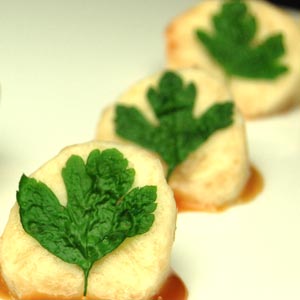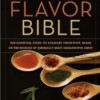Food Pairing in Molecular Gastronomy
Flavor is the combination of taste experienced on your tongue and the aroma you experience through your nose. It is believed that as much as 80 percent or more of what we perceive as taste is actually aroma. This is why when we have a cold the food we eat “tastes” bland.
Taste buds allow us to perceive only bitter, salty, sweet, and sour flavors. It’s the odor molecules from food that give us most of our taste sensation. The average person can discriminate between 4K to 10K different odor molecules.
Food pairing has been done over the history of cooking mostly through trial and error resulting in classic combinations like tomato with basil, bacon with eggs and cucumber with dill.
 However, this is changing with molecular gastronomy and the influence of scientists in the kitchen. The scientific method of food pairing was most famously applied by Heston Blumenthal, chef of The Fat Duck, and is based on the principal that foods combine well with one another when they have similar molecular compounds in common.
However, this is changing with molecular gastronomy and the influence of scientists in the kitchen. The scientific method of food pairing was most famously applied by Heston Blumenthal, chef of The Fat Duck, and is based on the principal that foods combine well with one another when they have similar molecular compounds in common.
Before he started using molecular profiling, Heston Blumenthal came up with the pairing of caviar with white chocolate in 1999 by pure experimentation. He knew that a sprinkle of salt on white chocolate would enhance the flavors and temper the sweetness. So he then started experimenting combining white chocolate with other salty ingredients like cured duck ham, anchovies and finally caviar which resulted in the perfect combination. “The rich smoothness of the chocolate and the buttery brininess of the caviar melted and melded deliciously in the mouth.” said Heston Blumenthal.
He then asked Firmenich scientist Francois Benzi if there was a scientific explanation of why such ingredients worked so well. The answer was that both have high levels of amines, a group of proteins that have broken down from their amino acid state and have chemical similarities to ammonia.
After that, Heston Blumenthal purchased the Volatile Compounds in Food (VCF) database and Steffen Arctander’s Perfume and Flavor Materials of Natural Origin to start exploring new pairings. Molecular profiling for food pairing was then born and has spawn odd combinations like:
- coffee and garlic
- mandarin and thyme
- cucumber and violet
- salmon and licorice
- banana and parsley (see Banana with Parsley Dust recipe)
- mango and pine extract
- oyster and passion fruit
The molecular profile of a single ingredient is so complex than even if it has several compounds in common with another, there could still be many other reasons why they don’t have a good affinity. So, as Heston Blumenthal says, molecular profiling is a great tool for creativity but it supports intuition, imagination and emotion rather than replacing them.
Molecular profiling can also be used to substitute an ingredient with a combination of other ingredients that all together have similar flavor components to the ingredient they are substituting. For example, fried bacon can be replaced with a combination of basmati rice, Beijing roasted duck, strawberry and black tea.
To find what pairs well with or can replace a specific ingredient I recommend the book “The Flavor Bible” and the website FoodPairing.
For interesting flavor pairing recipes visit this blog’s Flavor Pairing category.




 (4 votes, average: 4.00)
(4 votes, average: 4.00)

